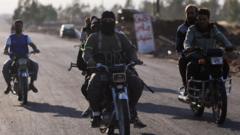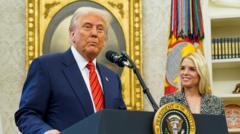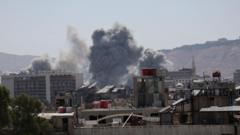During a recent Oval Office exchange, President Trump made numerous contested statements about violence against white farmers in South Africa. A fact-check reveals that many of his claims are misleading or unfounded, casting doubt on the narrative of "white genocide".
Examining Trump's Misstatements During Ramaphosa's Oval Office Visit

Examining Trump's Misstatements During Ramaphosa's Oval Office Visit
A fact-check of President Trump's claims regarding violence against white farmers in South Africa made during his meeting with President Cyril Ramaphosa.
Article text:
In a recent encounter in the Oval Office, President Donald Trump confronted South African President Cyril Ramaphosa over allegations concerning the violence against white farmers. The atmosphere, which began amicably, quickly grew tense as Trump presented a video aimed at supporting his controversial claims regarding the persecution of white minority farmers in South Africa.
The President showcased a series of video clips that included opposition politicians allegedly inciting violence against white farmers, and he provided Ramaphosa with articles he stated documented widespread brutality against this demographic. Claims of violence towards white South Africans have been amplified by several figures, including tech mogul Elon Musk and former television host Tucker Carlson, notably during Trump’s first term. Many of these assertions lack robust evidence.
One of the more contentious images Trump presented was of rows of crosses, which he suggested represented burial sites for murdered white farmers. However, fact-checking efforts reveal that these crosses memorialized a protest for Glen and Vida Rafferty, who were victims of violence in 2020. Local organizer Darrell Brown clarified that the crosses symbolized the estimated total fatalities of multiple murdered farmers, amounting to 500 in representation. Moreover, a review of Google Street View images indicates that these crosses no longer stand, further undermining Trump's grave characterization.
Trump additionally referenced a supposed genocide against white farmers, stating that many South Africans feeling persecuted sought refuge in the USA. Despite South Africa's high overall murder rate, SAPS statistics reveal that only 44 murders of individuals in the farming community were recorded last year, with just eight of those pertaining specifically to farmers. These figures are not race-detailed in public releases and do not substantiate the claims of a targeted genocide. A South African court recently dismissed the notion of "white genocide" as unfounded, reinforcing the historical complexities surrounding the issue.
The President also highlighted footage of rallies where anti-apartheid songs deemed inflammatory were sung. He attributed these incidents to officials, notably Julius Malema, who formerly led the ANC’s youth wing but has not held an official government position since 2012. Ramaphosa countered Trump’s assertions, noting that Malema leads a minor party, the Economic Freedom Fighters (EFF), and that the South African government disavows violence.
Furthermore, Trump attempted to provide evidence for his claims by brandishing graphics which he claimed depicted burial sites of white farmers. The image, however, was misidentified; it originated from a report concerning women being slain in the Democratic Republic of Congo, not South Africa.
As the tension between the two leaders unfolded, it became clear that Trump's narrative surrounding white farmer murders lacks factual corroboration. Observers and critics alike are now calling for a more accurate representation of the socio-political landscape in South Africa, away from politically charged rhetoric and towards grounded facts. In the wake of these claims, the conversation surrounding farmer safety and violence in South Africa continues to demand nuanced discourse, illustrating the complexities beyond mere headlines.
In a recent encounter in the Oval Office, President Donald Trump confronted South African President Cyril Ramaphosa over allegations concerning the violence against white farmers. The atmosphere, which began amicably, quickly grew tense as Trump presented a video aimed at supporting his controversial claims regarding the persecution of white minority farmers in South Africa.
The President showcased a series of video clips that included opposition politicians allegedly inciting violence against white farmers, and he provided Ramaphosa with articles he stated documented widespread brutality against this demographic. Claims of violence towards white South Africans have been amplified by several figures, including tech mogul Elon Musk and former television host Tucker Carlson, notably during Trump’s first term. Many of these assertions lack robust evidence.
One of the more contentious images Trump presented was of rows of crosses, which he suggested represented burial sites for murdered white farmers. However, fact-checking efforts reveal that these crosses memorialized a protest for Glen and Vida Rafferty, who were victims of violence in 2020. Local organizer Darrell Brown clarified that the crosses symbolized the estimated total fatalities of multiple murdered farmers, amounting to 500 in representation. Moreover, a review of Google Street View images indicates that these crosses no longer stand, further undermining Trump's grave characterization.
Trump additionally referenced a supposed genocide against white farmers, stating that many South Africans feeling persecuted sought refuge in the USA. Despite South Africa's high overall murder rate, SAPS statistics reveal that only 44 murders of individuals in the farming community were recorded last year, with just eight of those pertaining specifically to farmers. These figures are not race-detailed in public releases and do not substantiate the claims of a targeted genocide. A South African court recently dismissed the notion of "white genocide" as unfounded, reinforcing the historical complexities surrounding the issue.
The President also highlighted footage of rallies where anti-apartheid songs deemed inflammatory were sung. He attributed these incidents to officials, notably Julius Malema, who formerly led the ANC’s youth wing but has not held an official government position since 2012. Ramaphosa countered Trump’s assertions, noting that Malema leads a minor party, the Economic Freedom Fighters (EFF), and that the South African government disavows violence.
Furthermore, Trump attempted to provide evidence for his claims by brandishing graphics which he claimed depicted burial sites of white farmers. The image, however, was misidentified; it originated from a report concerning women being slain in the Democratic Republic of Congo, not South Africa.
As the tension between the two leaders unfolded, it became clear that Trump's narrative surrounding white farmer murders lacks factual corroboration. Observers and critics alike are now calling for a more accurate representation of the socio-political landscape in South Africa, away from politically charged rhetoric and towards grounded facts. In the wake of these claims, the conversation surrounding farmer safety and violence in South Africa continues to demand nuanced discourse, illustrating the complexities beyond mere headlines.





















